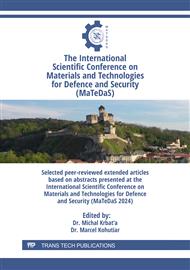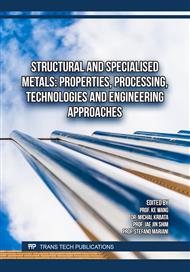[1]
R. A. Mesquita, Tool steels: properties and performance, CRC press, 2016.
Google Scholar
[2]
J. Escherová, H. Chochlíková, Application of quasi-static nanoindentation meth-od for the research of mechanical properties mi-crostructural components of tool steel, University Review 15 (2021) 45-50.
Google Scholar
[3]
K. Holmberg, A. Matthews, Coatings tribology: properties, mechanisms, techniques and applications in surface engineering, Elsevier, 2009.
Google Scholar
[4]
M. Krbata, M. Eckert, J. Majerik, I. Barenyi, Wear behaviour of high strength tool steel 90MnCrV8 in contact with Si3N4, Metals 10 (2020) 756.
DOI: 10.3390/met10060756
Google Scholar
[5]
L. J. Yang, D. N. Collins, Designing with Tool Steel, Handbook of Mechanical Alloy Design 164 (2003) 169.
Google Scholar
[6]
G. Di Benedetto, P. Matteis, G. Scavino, Impact behavior and ballistic efficiency of armor-piercing projectiles with tool steel cores, International Journal of Impact Engineering 115 (2018) 10-18.
DOI: 10.1016/j.ijimpeng.2017.12.021
Google Scholar
[7]
H. Berns, W. Theisen, W. Theisen, Tools for processing materials, Ferrous Materials: Steel and Cast Iron (2008) 271-305.
DOI: 10.1007/978-3-540-71848-2_9
Google Scholar
[8]
S. M. T. Omar, K. P. Plucknett, The influence of DED process parameters and heat-treatment cycle on the microstructure and hardness of AISI D2 tool steel. Journal of Manufacturing Processes, 81 (2022) 655-671.
DOI: 10.1016/j.jmapro.2022.06.069
Google Scholar
[9]
L. Bourithis, G. D. Papadimitriou, J. Sideris, Comparison of wear properties of tool steels AISI D2 and O1 with the same hardness, Tribology International 39 (2006) 479-489.
DOI: 10.1016/j.triboint.2005.03.005
Google Scholar
[10]
K. Singh, R.K. Khatirkar, S. G. Sapate, Microstructure evolution and abrasive wear behavior of D2 steel, Wear, 328 (2015) 206-216.
DOI: 10.1016/j.wear.2015.02.019
Google Scholar
[11]
M. H. Staia, Y. Pérez-Delgado, C. Sanchez, A. Castro, E. Le Bourhis, E. S. Puchi-Cabrera, Hardness properties and high-temperature wear behavior of nitrided AISI D2 tool steel, prior and after PAPVD coating, Wear 267 (2009) 1452-1461.
DOI: 10.1016/j.wear.2009.03.045
Google Scholar
[12]
C. Scandian, C. Boher, J. D. B. De Mello, F. Rezai-Aria, Effect of molybdenum and chromium contents in sliding wear of high-chromium white cast iron: The relationship between microstructure and wear, Wear 267 (2009) 401-408.
DOI: 10.1016/j.wear.2008.12.095
Google Scholar
[13]
K. F. Pinho, C. Boher, C. Scandian, Effect of molybdenum and chromium contents on sliding wear of high‐chromium white cast iron at high temperature, Lubrication Science 25 (2013) 153-162.
DOI: 10.1002/ls.1171
Google Scholar
[14]
R. M. Leed, Tool and die making troubleshooter, Society of Manufacturing Engineers, (2003).
Google Scholar
[15]
F. Findik, Latest progress on tribological properties of industrial materials, Materials & Design 57 (2014) 218-244.
DOI: 10.1016/j.matdes.2013.12.028
Google Scholar
[16]
M. Krbaťa, M. Eckert, D, Križan, I, Barényi, I, Mikušová, Hot deformation process analysis and modelling of x153crmov12 steel. Metals. 9 (2019)1125.
DOI: 10.3390/met9101125
Google Scholar
[17]
M. Krbaťa, J. Majerík, M. I, Barényi, Eckert, R. Čep, J. Sedlak, I. Samrdžić, Dilatometric analysis of cooling curves for high strength steel X155CrMoV12. Metalurgija. 61 (2022) 193-196.
Google Scholar
[18]
J. Escherová, M. Krbata, M. Kohutiar, I. Barényi, H. Chochlíková, M. Eckert, P. Dubcová, The Influence of Q & T Heat Treatment on the Change of Tribological Properties of Powder Tool Steels ASP2017, ASP2055 and Their Comparison with Steel X153CrMoV12, Materials 17 (2024) 974.
DOI: 10.3390/ma17050974
Google Scholar
[19]
M. Kohutiar, M. Krbata, J. Escherova, M. Eckert, P. Mikus, M. Jus, A. Dubec, The Influence of the Geometry of Movement during the Friction Process on the Change in the Tribological Properties of 30CrNiMo8 Steel in Contact with a G40 Steel Ball, Materials 17 (2023) 127.
DOI: 10.3390/ma17010127
Google Scholar
[20]
H.K.D.H. Bhadeshia, Steels for bearings, Prog. Mater. Sci. 57 (2012) 268–435.
Google Scholar
[21]
Z. Wang, H.M. Pu, Y.H. Kang, B.Q. Wang, Nondestructive testing method and application for internal defect of metal balls, Nondestruct. Test. Eval. 35 (2020) 177–189.
DOI: 10.1080/10589759.2019.1652296
Google Scholar
[22]
M.O.A. Mokhtar, The effect of hardness on the frictional behaviour of metals. Wear 78 (1982) 297-304.
DOI: 10.1016/0043-1648(82)90240-x
Google Scholar



